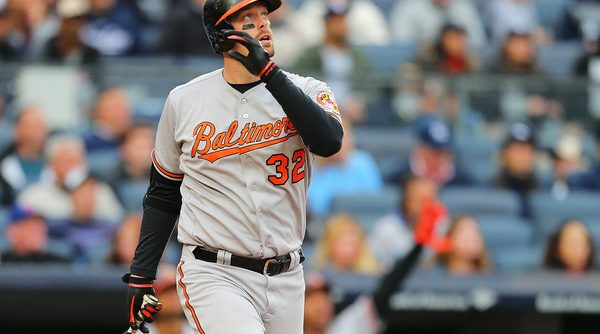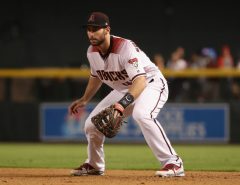After a solid career as an Oriole, Matt Wieters made the (usually not so) quick drive 95 to DC and will be donning the curly W in 2017. Wieters has some big shoes to fill as he steps in to take the place of Wilson Ramos. While Wieters is a consistent ball player, he won’t be able to replicate Ramos’ success.
A one-time top prospect, Wieters somehow still has that new prospect shine to him after nearly seven seasons in Baltimore. At least among casual fans, he’s still thought of as one of the top catchers in the game, which probably explains why his signing didn’t generate a whole lot of angst in DC. It’s a reputation that might not be totally deserved, however.
Part of that reputation is probably built on Wieters’ power. Prior to his Tommy John surgery, he had three straight seasons of 22 or more home runs. In 2016, his first full year back from TJ rehab, he slugged another 17 home runs. That kind of consistent power out of a catcher is hard to come by, so give Wieters credit for that. Unfortunately, that’s about the only area where Wieters really stands out.
In order to generate those home runs, Wieters has to swing at a lot of pitches. Pitches in the zone, pitches out of the zone — he doesn’t really differentiate all that much. To his credit, Wieters does a good job of making contact when he swings, so his strikeout rate is about league average even with all those swings. But so is his walk rate. Despite the double-digit home run numbers, Wieters doesn’t really have prodigious power, either. His ISO is only league average, so he’s hitting a lot of singles and fewer doubles.
Well, actually, there aren’t that many singles, either. Wieters is a career .256 hitter and has only once topped a .300 batting average. That year he hit .308? Propped up by a .329 BABIP. Now, that’s not a ridiculously high BABIP, mind you, but Wieters is a plodding catcher with a career .286 BABIP. That career .256 batting average should probably be the expectation heading into 2017.
Unfortunately, the story doesn’t get any better on the defensive side of things. Wieters has a good arm and controls the running game well. However, controlling the running game falls more on the pitcher’s shoulders than the catcher. So while his caught stealing rate is a feather in the cap for Wieters, it’s not the end-all, be-all metric for catchers. Where catchers do have much more influence is in pitch framing: receiving pitches in such a way that borderline balls become strikes. Over his career, Wieters has not been a good pitch framer. Instead of stealing borderline strikes, he turns borderline strikes into balls. In 2016, he was one of the worst everyday catchers and significantly worse than Jose Lobaton and Ramos. The Nationals will surely see a drop off in borderline called strikes shifting from Ramos to Wieters.
All told, he’s a competent big league bat with some pop. He will likely hit about .250 with an OBP around .300. He will probably hit close to 20 home runs again in 2017. That’s a useful profile coming out of a catcher, defensive shortcomings aside. From the Nationals perspective, the consistency in Wieters’ profile is reassuring because the team can bank on a certain level of performance. For a team with championship aspirations, variance is a risk not worth taking, which is why Derek Norris got the ax. Though Norris’ offensive peak is better than anything Wieters has ever accomplished, Norris was also coming off a year where he was one of the worst hitters in all of baseball. That was a risk the Nationals just couldn’t take. While Wieters in 2017 will certainly be a step down from Ramos in 2016, the Nationals have other pieces that can make up for that loss (see: Harper, Bryce; Turner, Trea). If the only complaint about Wieters in 2017 is that he didn’t match Ramos’ 2016 season swing-for-swing, that probably means it was a successful season for the Nationals.
Tags: 2017 player previews, Matt Wieters, Nationals, Nats, Washington Nationals




Leave a Reply